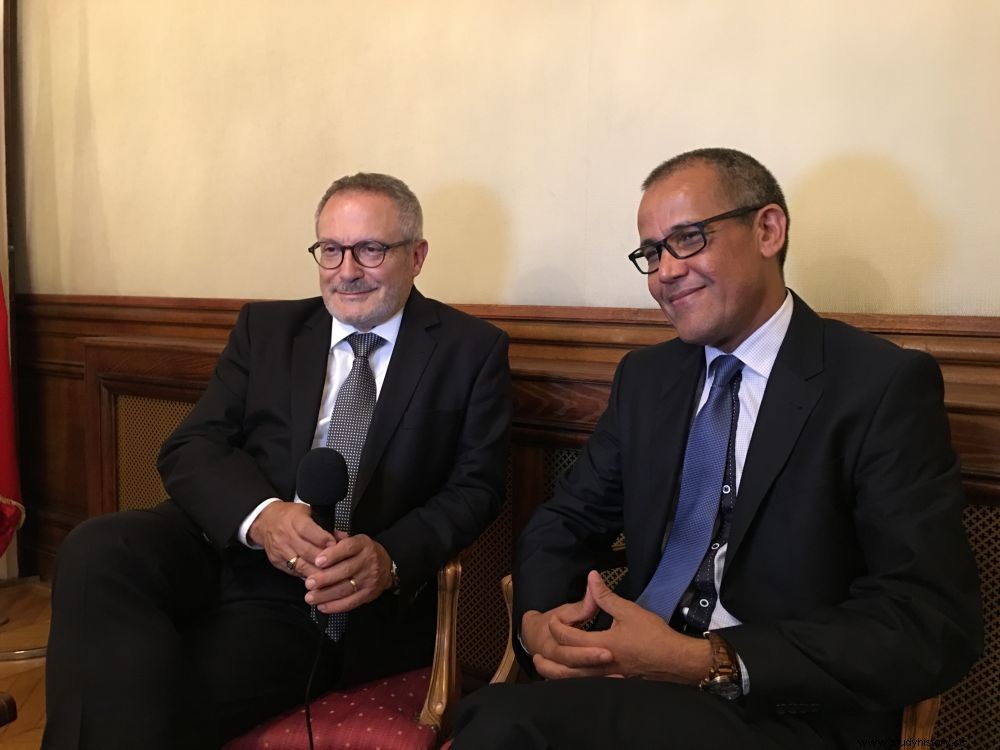Professor Hublin and his colleague Abdelouahed ben-Ncer were at the Moroccan Embassy in Paris on July 11, 2017 for a conference on their findings of 300,000-year-old fossils from Jebel Irhoud, Morocco. Science and the Future met them there.

Jean-Jacques Hublin and Abdelouahed ben-Ncer, discoverers of "the 300,000-year-old man", were on July 11, 2017 at the Moroccan Embassy in Paris.
On the same subject, find the article "Homo sapiens is getting old" by our journalist Rachel Mulot in Sciences et Avenir 845, dated July 2017, which features on the cover of "A New History of the Universe".
It is an extraordinary Moroccan archaeological site that the Embassy of the Kingdom in Paris put in the spotlight on Tuesday, July 11, 2017. A "martyr" site , as Professor Abdelouahed ben-Ncer said in the interview he gave us (see below):Jebel Irhoud has long been exploited as a barite mine (a substance necessary for oil exploitation) , until workers brought to the surface, in the 1960s, the top of a prehistoric skull. Since then, 22 remains of Homo sapiens were discovered there. Fossils that spectacularly wind up the clocks, since they have been dated -300,000 years. In other words, with the Jebel Irhoud man, it appears that Homo sapiens is 100,000 years older than expected!
This dating was carried out by the teams of Professor ben-Ncer (Insap, Rabat, Morocco) and his colleague Jean-Jacques Hublin (Max-Planck Institute, Leipzig, Germany). Both had therefore responded to the invitation of the Moroccan ambassador to present their discovery at a conference which focused on the "pan-African" origin of modern man. If scientists have long believed that Homo sapiens was originally from East Africa, it is in fact throughout the continent that he has roots. "This invalidates the pattern that has prevailed until now, and that modern man appeared quite abruptly, about 200,000 years ago; an almost adamic creation in a kind of garden of Eden sub -Saharan" explains, wielding biblical metaphor, Professor Hublin.
"We are all Africans"
At -300,000, the appearance of Homo sapiens is so much older. And its evolution, slow. Because if the men of Jebel Irhoud are very close to us by certain anatomical aspects - the face, the teeth for example -, they present differences with the current men, in particular with regard to their brain. "He was tall, but different from ours" , specifies Jean-Jacques Hublin, who adds:"The great deal of our evolution over the last 300,000 years is indeed our brain".
The discovery of Jean-Jacques Hublin and Abdelouahed ben-Ncer made headlines in the international press. If the media opened their pages to him, did the scientific community show some friction in front of his new datings which upset the dogmas? "No, replies Jean-Jacques Hublin simply.The method of dating by thermoluminescence that we used is not open to dispute". He notes that the only criticism, issued in the pages of Monde by Professor Jean-Jacques Jaeger based on the age of Jebel Irhoud rodents, has fizzled.
But if there is a country where the 300,000 year old man has made more waves than elsewhere, it is undoubtedly Morocco. "I am amazed to see the enthusiasm of Moroccans for this discovery, attests Professor ben-Ncer. This is particularly visible on social media, where Jebel Irhoud has become a favorite topic." Twitter and Homo sapiens , finally brought together in a single gesture thanks to the discovery of Jebel Irhoud. It also demonstrates, in the words of Jean-Jacques Hublin, that "we are all Africans".
